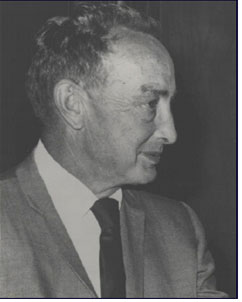Mr. Floyd I. Abel
 Born on June 17, 1917, in Pennsville,
Ohio, Floyd I. Abel graduated from Ohio State University in 1939 with a degree in mechanical engineering. He went
to work for the Ordnance Department as a civilian Inspector of Ordnance Materiel. During World War II, he
interrupted his civilian career to accept a commission in 1942 as an Ordnance lieutenant serving as Chief of the
Artillery Maintenance Engineering Branch in the Office of the Chief of Ordnance. Given his proven expertise in
artillery and fire control, he was sent to the European Theater for a year to investigate artillery malfunction
reports.
Born on June 17, 1917, in Pennsville,
Ohio, Floyd I. Abel graduated from Ohio State University in 1939 with a degree in mechanical engineering. He went
to work for the Ordnance Department as a civilian Inspector of Ordnance Materiel. During World War II, he
interrupted his civilian career to accept a commission in 1942 as an Ordnance lieutenant serving as Chief of the
Artillery Maintenance Engineering Branch in the Office of the Chief of Ordnance. Given his proven expertise in
artillery and fire control, he was sent to the European Theater for a year to investigate artillery malfunction
reports.
Returning to the United States in 1944, Abel was assigned as Chief, Artillery Branch, Rock Island Arsenal Field Services Sub-Office. Abel left the service in 1946 to resume his work as a Department of the Army civilian, soon advancing to Chief of the Maintenance Division at Rock Island Arsenal. In 1955, with the establishment of the Ordnance Weapons Command at Rock Island, he became Director of its National Maintenance Point. In 1962, when Army Materiel Command's US Army Weapons Command assumed the responsibilities of the Ordnance Weapons Command, Abel continued his work as Director of the National Maintenance Point and, in 1971, as Director of Maintenance until his retirement in 1972.
Although the name of his organization changed several times, Abel was responsible throughout his tenure at Rock Island for ensuring that maintainability was considered in weapons design; developing maintenance procedures, tools, and publications for weapons systems; managing depot rebuild programs; and for investigating malfunction reports. In 1957, he developed a checklist of preventive maintenance indicators that allowed commanders to quickly assess the condition of their weapons systems and their units' maintenance readiness.
Also in 1957, Abel created the first Maintenance Operations Procedures Shop to test maintenance procedures prior to publishing maintenance manuals, to assist in equipment malfunction investigations, and to develop Test, Measurement, and Diagnostic Equipment (TMDE). Starting in 1960, he trained and dispatched maintenance customer assistance teams to train US and allied units and equipment operators in the maintenance of their weapons systems.
In 1961, Abel developed the Organizational Operation Log for units to record the data, number, and type of rounds fired from artillery and tank main gun tubes, thus tracking wear and allowing for planning of maintenance and tube replacement. Beginning in 1962, he was instrumental in converting an old US Navy seaplane tender into a floating helicopter maintenance facility, the USNS Corpus Christi Bay, which provided in-theater maintenance support to Army aviation units during the Vietnam War. He played a key role in maintenance planning, in automating depot maintenance management systems, and in developing maintenance procedures and manuals for a host of new weapons systems, to include the M16 rifle, the M60 tank, and the M551 Sheridan. Floyd Abel retired in 1972 after 33 years of dedicated military and civilian service. He died in 1978.